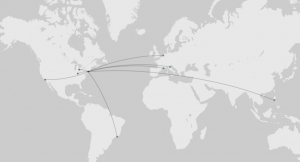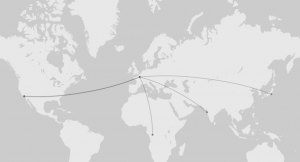“Hip hop does not simply draw inspiration from a range of samples, but it layers these fragments into an artistic object. If sampling is the first level of hip hop aesthetics, how the pieces or elements fit together constitute the second level.” [1]
Samples have a history. In the earlier exploration of the history of the KRS-One song “Sound of da Police”, we looked into the history of the samples that made up the song itself. I then traced the song’s movement to France and further abroad as a sample within other hip-hop tracks. Mapping “Sound of da Police” looks like this:

And when we add some of its own sampling history, the map looks like this:

Artists as diverse as Tricky, Different Teep, Koma, Colle Der Fomer, and Cut Killer have all sampled aspects of “Sound of da Police” in London, Rome, Paris, and as far East as Romania. The direction of these samples is emblematic of larger trends in hip-hop’s global ascendence. During the 1990s and early 2000s, the samples that were the basis for hip-hop remained embedded in African-American musical traditions such as Soul, R&B, Jazz, and Rock. Further examples of this trend include the Notorious BIG’s “Machine Gun Funk,” has a very simple West-to-East trajectory.[2]

The result has been that as hip-hop has gone global, many of its earliest non-North American artists also drew deeply from the well of American Soul and Funk records. Racionais MCs, the São Paulo-based group drew heavily from the catalogs of James Brown, Isaac Hayes, the J.B.’s, the Blackbyrds, The Honey Drippers, and Michael Jackson. IAM, a French group based in Marseilles, and Suprême NTM in Paris were similar in orientation. MC Solaar, another French MC was one of the first French rappers to gain a measure of fame in France and in the United States by collaborating with Guru, one half of the Jazz-based hip-hop team of Gangstarr.
Solaar and Guru’s “Le Bien, Le Mal” was one one of the first collaborations between French and North American MCs, featuring raps in both English and French. The song’s samples, however, were all North America: Lou Donaldson’s “Pot Belly” and the Skull Snaps’ “It’s a New Day.” Other tracks from IAM, Suprême NTM, and Kerry James have relied on samples from Lyn Collins, Public Enemy, Marvin Gaye, and James Brown. Thus, the song, when mapped, looks very much like “Sound of da Police” or “Machine Gun Funk.” Another example is Public Enemy’s “Bring the Noise.”

Originally released on the soundtrack to the Brat Pack/Brett Easton Ellis movie Less than Zero, “Bring the Noise” was a powerful track that resonated, both in the United States and abroad. Public Enemy’s signature sound was the result of The Bomb Squad, the brothers Hank and Keith Shocklee, in Roosevelt, New York.

In many ways, mapping the way in which “Bring the Noise” has been sampled transcends the actual boundaries of the Atlantic. Noting this reliance on North American samples in French hip-hop, which has the most diverse and largest scene outside of the United States, is not meant as criticism for French hip-hop’s DJs nor its producers. Hip-hop’s “sound” was built on an important subset of samples including famous sections from “Amen, Brother” by the Winstons, “Funky Drummer” by James Brown, “Impeach the President” by the Honey Drippers, as well as many, many others. WhoSampled lists some of these samples as having hundreds of artists sampling them and while many of those samples are not in hip-hop tracks, their resonance in hip-hop has made them almost indispensable for any DJ.[3]
In the late 1990s and early 2000s, however, things began to change. The rise of African hip-hop, especially in Dakar, Lagos, Cape Town, and Accra led to important revisions of the relationship between North American samples and African ones. DJs and Producers, especially in France, have begun sampling African, Asian, and French music in their tracks. A recent example is Youssoupha Mabiki, who was born in Kinshasa, Congo (in what was then Zaire). The son of famous Congolese Rumba musician Tabuley Rochereau, Youssoupha has made a name for himself in the French hip-hop scene. Noir Desír, his 2012 release, samples very little American music, and what is sampled is recent, Mike Shinoda’s Fort Minor. The other samples from the album include music from Congo, India, Tokyo, and France.

Aladji Man, an MC for the Senegalese-based hip-hop collective Daara J encapsulates this relationship in a verse from 2003’s Boomerang, “Born in Africa, brought up in America, hip hop has come full circle.” [4]
[2] Because samples from Black Heat, Lords of the Underground, Maceo Parker, and Tina Turner were all recorded in Los Angeles, the map resembles a single line, but the lack of complexity available with the current tools obscures the multiple samples originating from the same location.
[3] The Winstons’ “Amen Brother” has even spawned entire genres of music through its use, and reuse, in a variety of forms in UK Jungle
How to cite this page: Romine, David T., “A Sonic Map of the Black Atlantic” Deeps, The Black Atlantic, Duke University, http://sites.duke.edu/blackatlantic/ (accessed on (date)).